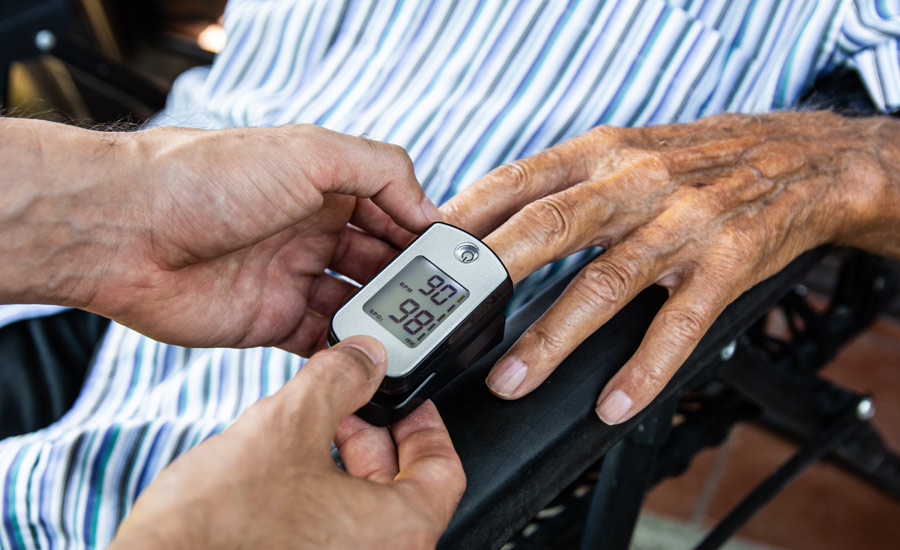Caring for Residents with COPD in Care Homes

COPD is a common lung condition among older adults, and for residents in care homes, it can mean living with ongoing breathlessness and the risk of sudden flare-ups.
In England, about 11.1% of all COPD deaths occur in care homes, so managing the condition is a priority for care staff.
If you’re a family member worrying about how these challenges are managed in your loved one’s care home, this article will talk about all of the practical steps care homes take to support residents with COPD and manage breathing problems day-to-day.
How Do Care Homes Manage Breathing Problems in COPD Patients?
Care homes manage breathing problems in COPD patients by supporting the use of inhalers or nebulisers, checking oxygen levels and watching for changes in breathing. If symptoms worsen, staff will promptly involve GPs or nurses so that their treatment can be adjusted before the situation deteriorates.
COPD in Care Homes
COPD affects a person’s ability to breathe, and residents with the condition may struggle with shortness of breath during even simple activities, such as walking to the dining room or getting dressed. Fatigue, persistent coughing and a higher risk of chest infections are also common with COPD.
For carers, this means keeping a close eye on how a resident is coping throughout the day. Even small changes, such as needing to rest more often, avoiding meals or showing signs of breathlessness at night, can signal that support needs to be adjusted.
Interestingly, COPD can be stable for weeks, then flare up suddenly, which can be scary for everyone involved. It’s that unpredictability that makes ongoing monitoring and rapid response is critical in care home settings.
COPD Daily Monitoring and Observation
For someone with COPD, small changes in breathing can quickly escalate into a serious problem. That’s why monitoring becomes a regular part of everyday routines. That means that staff will notice if a resident is more breathless walking to the dining room, coughing during the night or avoiding meals because eating feels like too much effort. All these subtle signs often appear before a flare-up, giving staff a chance to act early.
Pulse oximeters are used to measure oxygen levels, particularly if a resident seems more tired or is breathing faster than usual. A reading below 92% can indicate that the oxygen supply is dropping, and in that case, staff should quickly escalate to a nurse or GP. Recording these readings over time also helps doctors adjust treatment, for example, by changing inhaler strength or prescribing rescue medication.
It’s not just about numbers, though. Staff create a picture of each resident’s normal breathing pattern and energy levels, so they can spot a downturn more accurately than a one-off medical visit ever could. Given that up to one in five COPD exacerbations leads to hospital admission in older adults, this kind of observation is crucial.
Medication and Inhaler Support
Inhalers, nebulisers and oxygen therapy can control symptoms and reduce the risk of flare-ups. But for COPD medication to work, it has to be taken in the right way and care staff must pay attention to how inhalers are used and whether residents are getting the full benefit.
Residents might find inhalers difficult to use, either because of reduced hand strength or problems with coordination. And studies suggest that up to two-thirds of patients make errors with inhaler technique, which means the medication doesn’t reach the lungs as it should do.
In a care home, trained staff guide residents through the process, check technique and record each dose given. Where needed, a nebuliser may be used instead, providing the same medication in a mist that’s easier to breathe in.
GPs or respiratory nurses will review medications regularly, ensuring that residents aren’t on outdated treatment plans and that any side effects are managed promptly. For example, steroids used during a flare-up can weaken bones over time, so staff keep an eye on diet and bone health too.
Managing COPD Flare-Ups and Exacerbations
A flare-up can develop over hours or days, and as mentioned previously, care home staff are taught to respond as soon as the first signs appear.
Symptoms of a COPD flare are breathlessness that suddenly worsens, a chest that feels tighter than usual or a change in the colour or amount of phlegm. When this happens, the first step is to keep the resident calm and comfortable. Some steps staff might take is adjusting the resident’s sitting position to make breathing easier, while checking oxygen saturation with a pulse oximeter and encouraging steady breathing techniques. If a resident has a prescribed antibiotic or steroids, staff can start that treatment straight away while contacting a GP for advice.
Unfortunately, some flare-ups need urgent intervention. If oxygen levels drop sharply or breathing becomes severely laboured, carers will know to call for emergency care and having observations and records ready means paramedics or hospital teams can act quickly with the correct information.
Reducing Triggers in the Care Environment
For residents with COPD, the care home surroundings they live in can either ease symptoms or make them worse. That’s why care staff take practical steps to cut down on common COPD flare triggers so residents can breathe more comfortably.
Air quality is one of the biggest factors, because even small amounts of smoke, strong cleaning products or dust can set off coughing and breathlessness. Homes reduce this risk by keeping living areas well-ventilated, using gentler cleaning agents and maintaining strict no-smoking policies indoors.
Around 70% of COPD flare-ups are linked to respiratory infections, so vaccination against flu and pneumonia is encouraged and good hand washing hygiene is encouraged throughout the day. Staff also monitor residents more closely during the winter months when viruses circulate more widely.
Some of the support is very practical, with residents being reminded to drink enough water, as dehydration can thicken mucus and make breathing more difficult. On hot or humid summer days, staff may move activities indoors or shorten them to prevent strain. Gentle exercise is enabled too, often with a physiotherapist’s input, to keep lungs and muscles working without pushing residents too far. Each of these adjustments can reduce the risk of a flare-up.
Breathing Support That Changes Lives
With a clear plan followed consistently, COPD care in residential homes remains stable, thanks to staff picking up early changes, checking inhaler technique and starting rescue medication when needed, keeping care in the home, reducing avoidable hospital trips and helping residents breathe easier each day.
Ready to explore...
